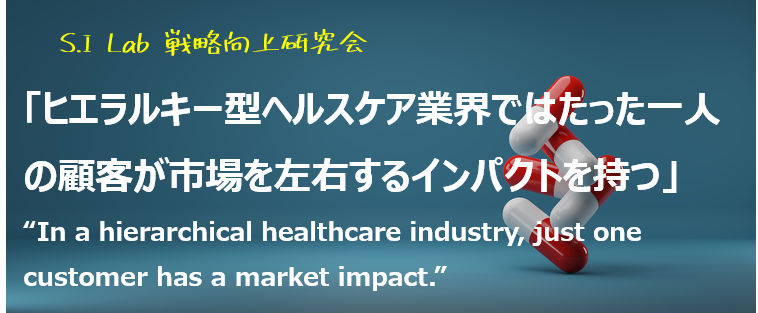広島大学での寄付講座めぐる医師からの処方への働き掛け、いわゆる「利益相反問題」は記憶に新しいと思います。
これはヒエラルキー型組織におけるたった一人の顧客が持つ影響力を示す一例です。
ターゲットマーケティングである医薬品ビジネスが、受注確率の高い顧客を抽出する消費材ビジネスと根本的に異なるのは、受注確率がゼロの顧客であっても影響力の高い顧客であれば攻略が必須だということです。
例えその顧客ランクが市場規模によるパレート分類では低く設定されていたとしてもです。
このような地域特性での影響力まで本社で把握することは困難でしょう。
スライドで示す事例では3強型市場で最もシェアが低い競合製品Bが最も競争優位性が高く、
逆に最もシェアの高い競合製品Aは非常に脆弱な競争環境だということが分かります。
マトリクス分析法は外見上の優劣だけでは見えない、競争環境における脆弱性を明らかにすることが出来ます。
“In a hierarchical healthcare industry, just one customer has a market impact.”
The so-called “problem of conflict of interest”, is still fresh in our minds regarding doctor tried to promote specific drugs for endowed courses at Hiroshima University.
This is an example of the power of a single customer’s influence in a hierarchical organization.
The pharmaceutical business, which is targeted marketing, is fundamentally different from the consumer goods business, which extracts customers with a high probability of receiving orders.
Even if the customer rank is set low in the Pareto classification by market size.
It would be difficult for the head office to grasp the influence of such regional characteristics.
In the example shown in the slide, competitor product B, which has the lowest share in three products competition, has the highest competitive advantage.
Conversely, you can see that competitive product A, which has the highest market share, has a very weak competitive environment. The matrix analysis method can reveal vulnerabilities in a competitive environment that cannot be seen only by outward superiority or inferiority.

